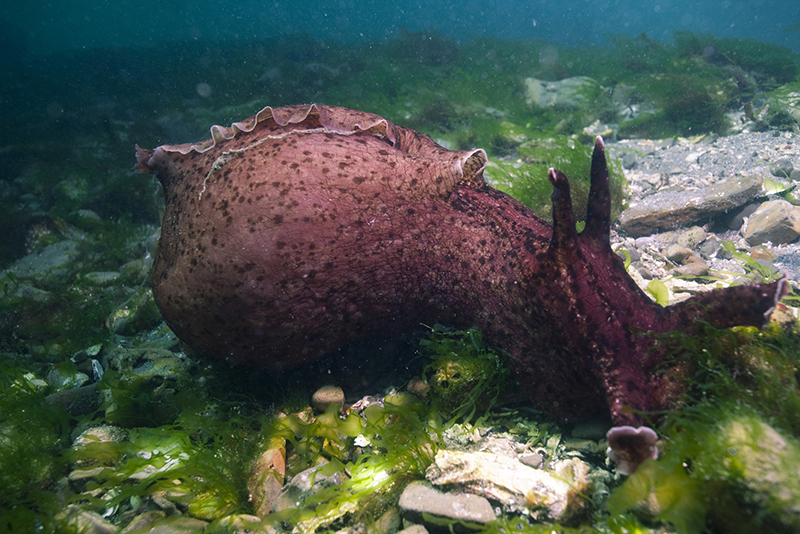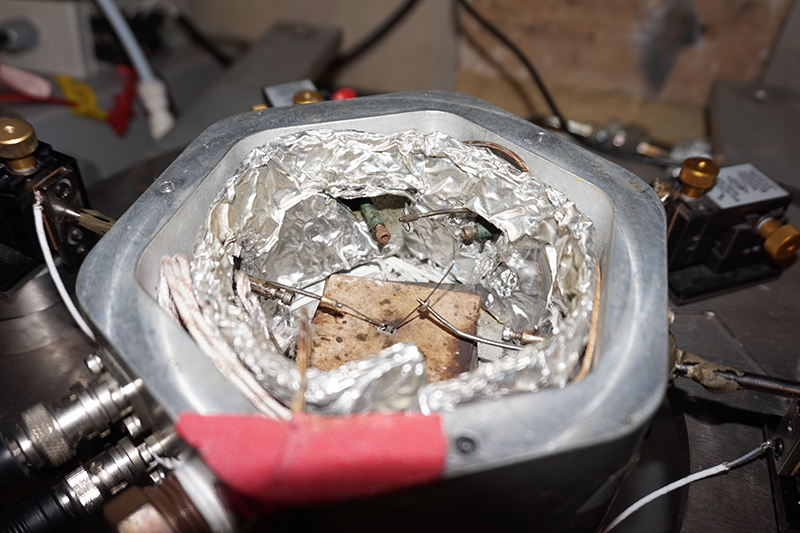September 14, 2021
Taking lessons from a sea slug, study points to better hardware for artificial intelligence

The sea slug has taught neuroscientists the intelligence features that any creature in the animal kingdom needs to survive. Now, the sea slug is teaching artificial intelligence how to use those strategies. Pictured: Aplysia californica. (NOAA Monterey Bay National Marine Sanctuary photo/Chad King)
Researchers mimic the animal kingdom’s most basic signs of intelligence in quantum material
WEST LAFAYETTE, Ind. — For artificial intelligence to get any smarter, it needs first to be as intelligent as one of the simplest creatures in the animal kingdom: the sea slug.
A new study has found that a material can mimic the sea slug’s most essential intelligence features. The discovery is a step toward building hardware that could help make AI more efficient and reliable for technology ranging from self-driving cars and surgical robots to social media algorithms.
The study, publishing this week in the Proceedings of the National Academy of Sciences, was conducted by a team of researchers from Purdue University, Rutgers University, the University of Georgia and Argonne National Laboratory.
“Through studying sea slugs, neuroscientists discovered the hallmarks of intelligence that are fundamental to any organism’s survival,” said Shriram Ramanathan, a Purdue professor of materials engineering. “We want to take advantage of that mature intelligence in animals to accelerate the development of AI.”
 By stimulating this quantum material (tiny gray-and-black striped rectangle, center) with gases, researchers discovered that the material could mimic basic forms of learning found in the sea slug. (Purdue University photo/Kayla Wiles)
Download image
By stimulating this quantum material (tiny gray-and-black striped rectangle, center) with gases, researchers discovered that the material could mimic basic forms of learning found in the sea slug. (Purdue University photo/Kayla Wiles)
Download image
Two main signs of intelligence that neuroscientists have learned from sea slugs are habituation and sensitization. Habituation is getting used to a stimulus over time, such as tuning out noises when driving the same route to work every day. Sensitization is the opposite – it’s reacting strongly to a new stimulus, like avoiding bad food from a restaurant.
AI has a really hard time learning and storing new information without overwriting information it has already learned and stored, a problem that researchers studying brain-inspired computing call the “stability-plasticity dilemma.” Habituation would allow AI to “forget” unneeded information (achieving more stability) while sensitization could help with retaining new and important information (enabling plasticity).
In this study, the researchers found a way to demonstrate both habituation and sensitization in nickel oxide, a quantum material. The material is called “quantum” because its properties can’t be explained by classical physics.
If a quantum material could reliably mimic these forms of learning, then it may be possible to build AI directly into hardware. And if AI could operate both through hardware and software, it might be able to perform more complex tasks using less energy.
“We basically emulated experiments done on sea slugs in quantum materials toward understanding how these materials can be of interest for AI,” Ramanathan said.
Neuroscience studies have shown that the sea slug demonstrates habituation when it stops withdrawing its gill as much in response to being tapped on the siphon. But an electric shock to its tail causes its gill to withdraw much more dramatically, showing sensitization.
For nickel oxide, the equivalent of a “gill withdrawal” is an increased change in electrical resistance. The researchers found that repeatedly exposing the material to hydrogen gas causes nickel oxide’s change in electrical resistance to decrease over time, but introducing a new stimulus like ozone greatly increases the change in electrical resistance.
Inspired by these findings, a research group under Kaushik Roy, Purdue’s Edward G. Tiedemann Jr. Distinguished Professor of Electrical and Computer Engineering, modeled nickel oxide’s behavior and built an algorithm that successfully used these habituation and sensitization strategies to categorize data points into clusters.
“The stability-plasticity dilemma is not solved at all. But we’ve shown a way to address it based on behavior we’ve observed in a quantum material,” Roy said. “If we could turn a material that learns like this into hardware in the future, then AI could perform tasks much more efficiently.”
For practical use of quantum materials as AI hardware, researchers will need to figure out how to apply habituation and sensitization in large-scale systems. They also would have to determine how a material could respond to stimuli while integrated into a computer chip.
This study is a starting place for guiding those next steps, the researchers said. In addition to the experiments performed at Purdue, a team at Rutgers University performed detailed theory calculations to understand what was happening within nickel oxide at a microscopic level to mimic the sea slug’s intelligence features. Argonne National Laboratory characterized the nickel oxide sample’s properties and the University of Georgia measured conductivity to further analyze the material’s behavior.
The work received funding from multiple entities, including the National Science Foundation, the Air Force Office of Scientific Research, the Army Research Office, the Office of Naval Research, and the Center for Brain Inspired Computing, a Joint University Microelectronics Program center sponsored by the Semiconductor Research Corporation and the Defense Advanced Research Projects Agency. The research used the resources of the Advanced Photon Source, a U.S. Department of Energy Office of Science User Facility operated for the DOE Office of Science by Argonne National Laboratory.
About Purdue University
Purdue University is a top public research institution developing practical solutions to today’s toughest challenges. Ranked in each of the last four years as one of the 10 Most Innovative universities in the United States by U.S. News & World Report, Purdue delivers world-changing research and out-of-this-world discovery. Committed to hands-on and online, real-world learning, Purdue offers a transformative education to all. Committed to affordability and accessibility, Purdue has frozen tuition and most fees at 2012-13 levels, enabling more students than ever to graduate debt-free. See how Purdue never stops in the persistent pursuit of the next giant leap at https://purdue.edu/.
Writer, Media contact: Kayla Wiles, 765-494-2432, wiles5@purdue.edu
Sources: Shriram Ramanathan, shriram@purdue.edu
Kaushik Roy, kaushik@purdue.edu
ABSTRACT
Neuromorphic learning with Mott insulator NiO
Zhen Zhang, Sandip Mondal, Subhasish Mandal, Jason M. Allred, Neda Alsadat Aghamiri, Alireza Fali, Zhan Zhang, Hua Zhou, Hui Cao, Fanny Rodolakis, Jessica L. McChesney, Qi Wang, Yifei Sun, Yohannes Abate, Kaushik Roy, Karin M. Rabe, Shriram Ramanathan
Habituation and sensitization (non-associative learning) are among the most fundamental forms of learning and memory behavior present in organisms that enables adaptation and learning in dynamic environments. Emulating such features of intelligence found in nature in the solid state can serve as inspiration for algorithmic simulations in artificial neural networks and potential use in neuromorphic computing. Here, we demonstrate non-associative learning with a prototypical Mott insulator, nickel oxide (NiO), under a variety of external stimuli at and above room temperature. Similar to biological species such as Aplysia, habituation and sensitization of NiO possesses time-dependent plasticity relying on both strength and time-interval between stimuli. Combination of experimental approaches and first-principles calculations reveal that such learning behavior of NiO results from dynamic modulation of its defect and electronic structure. An artificial neural network model inspired by such non-associative learning is simulated to show advantages for unsupervised clustering task in accuracy and reducing catastrophic interference, which could help mitigate the stability-plasticity dilemma. Mott insulators can therefore serve as building blocks to examine learning behavior noted in biology and inspire new learning algorithms for artificial intelligence.
Note to journalists: For a copy of the paper, please contact Kayla Wiles, Purdue News Service, at wiles5@purdue.edu or 765-494-2432. Higher-resolution photos of the quantum material experiments are available in a Google Drive folder. Journalists visiting campus should follow visitor health guidelines.

